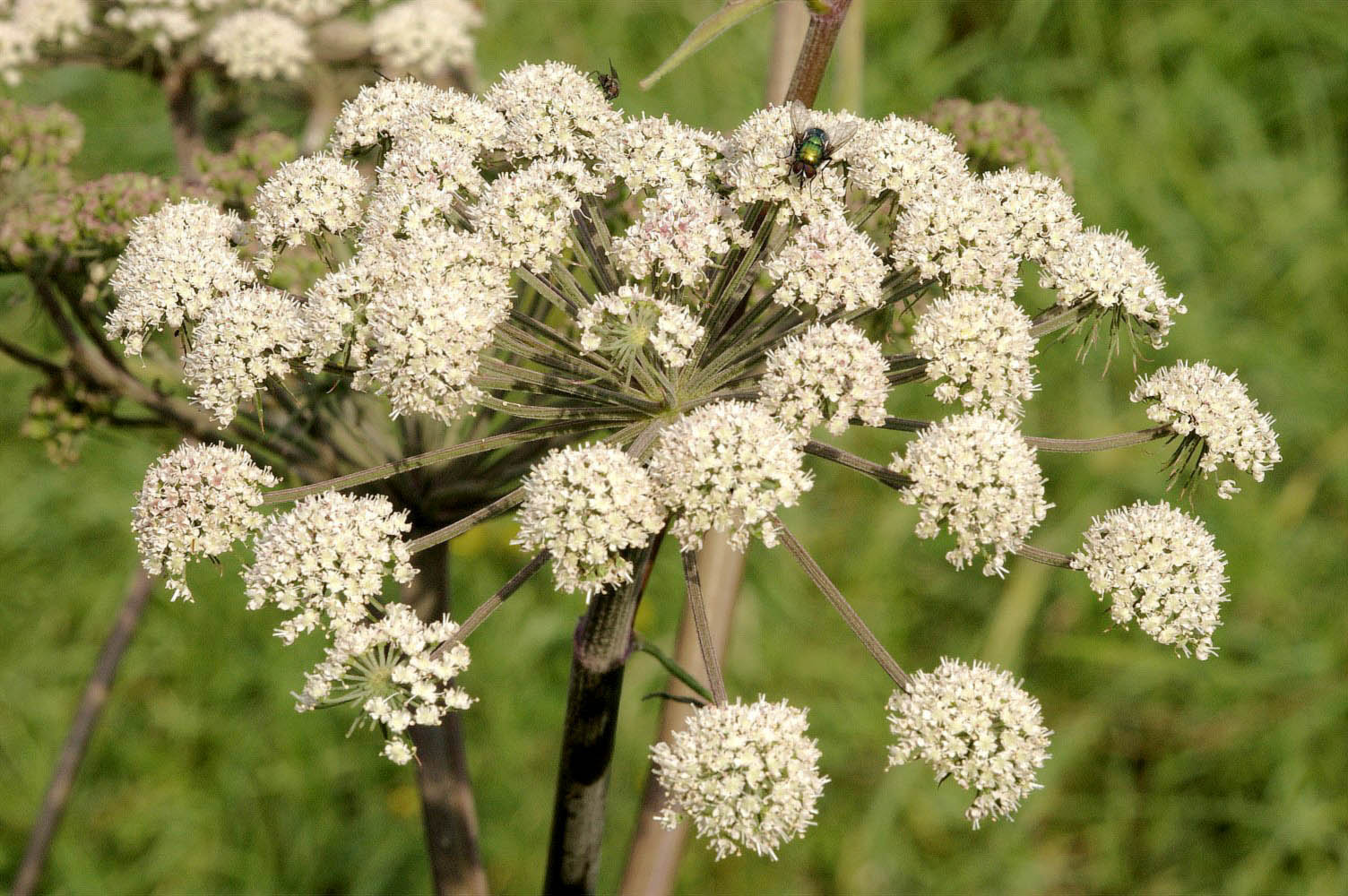- Apiaceae
image_width = 300px
image_caption = Inflorescence ofWild Angelica ("Angelica sylvestris")
regnum =Plant ae
divisio = Magnoliophyta
classis = Magnoliopsida
ordo =Apiales
familia = Apiaceae (or Umbelliferae)
familia_authority = Lindl.
type_genus = "Apium "
type_genus_authority = L.
subdivision_ranks = Genera
subdivision = including:
*"Anethum "
*"Anthriscus "
*"Angelica "
*"Apium "
*"Arracacia "
*"Carum "
*"Centella "
*"Conium "
*"Coriandrum "
*"Cuminum "
*"Daucus "
*"Eryngium "
*"Foeniculum "
*"Levisticum "
*"Myrrhis "
*"Pastinaca "
*"Petroselinum "
*"Pimpinella "For complete list, seeList of Apiaceae genera .The Apiaceae or Umbelliferae (both names are allowed by the ICBN) is a family of usually aromatic
plant s with hollow stems, commonly known as umbellifers. It includescumin ,parsley ,carrot ,coriander /cilantro ,dill ,caraway ,fennel ,parsnip ,celery , Queen Anne's Lace and other relatives. It is a large family with about 300 genera and more than 3,000species . The earlier name Umbelliferae derives from theinflorescence being generally in the form of a compound "umbel", and has the same root as the word "umbrella ", for obvious reasons. The botanical subspeciality that studies Apiaceae is sometimes called "sciadophytography".Description
The small flowers are radially symmetrical with 5 small
sepal s, 5petal s and 5stamen s.The family includes some highly
toxic plants, such as hemlock. Many plants in this family, such aswild carrot , haveestrogen ic properties and have been used asfolk medicine forbirth control . Most notable for this use is the extinct giant fennel,silphium . The cultivated plants in this category are almost all considered goodcompanion plant s, as the umbrella of tiny flowers attracts omnivorousbeneficial insect s, especially parasitic wasps and predatory flies, which then will hunt insect pests on nearby crops.The family is closely related to
Araliaceae and the boundaries between these families remain unclear. Some recent systems include Araliaceae in an expanded Apiaceae but this has not been widely followed. "Hydrocotyle" and "Trachymene", traditionally included in Apiaceae, are now generally included in Araliaceae.Notable members include "Anethum graveolens" -
Dill , "Anthriscus cerefolium" -Chervil , "Angelica" spp. -Angelica , "Apium graveolens" -Celery , "Arracacia xanthorrhiza" -Arracacha , "Carum carvi" -Caraway , "Centella asiatica" -Gotu Kola (pennywort), "Conium maculatum" - Poison hemlock, "Coriandrum sativum" -Coriander , "Cuminum cyminum" -Cumin , "Daucus carota" -Carrot , "Eryngium" spp. -Sea holly , "Foeniculum vulgare" -Fennel , "Myrrhis odorata" -Cicely , "Ferula gummosa" -galbanum , "Pastinaca sativa" -Parsnip , "Petroselinum crispum" -Parsley , "Pimpinella anisum" -Anise , "Levisticum officinale" - LovageCultivation
Many members of this plant group are cultivated, for various purposes. The plant structure includes a
tap root , which on more than one occasion has been bred to grow large enough to be useful in food, as with parsnips, carrots, and hamburg root parsley. Plants of this category also are adapted to conditions that encourage heavy concentrations ofessential oil s, so that some are used as flavorfull/aromatic herbs, including parsley, cilantro, and dill. The plentiful seeds of the umbers, likewise, are sometimes used in cuisine, as with coriander, fennel, cumin, and caraway.Companion Plants
Almost every widely cultivated plant of this group is a
companion plant . In large part, this is because the tiny flowers forming the umbers, for which the group is named, are perfectly suited forparasitic wasp s and predatoryflies , which actually drink nectar when not reproducing. They then will prey upon insect pests on nearby plants.Some of the plants, too, are herbs that produce enough scent to possibly dilute the odors of nearby plants, or the
pheromone s or emitted by insects that find those plants, which would otherwise attract more pests.See also
*
List of culinary herbs and spices
*List of culinary vegetables
*List of plants with edible leaves External links
* [http://herbarium.uvsc.edu/Virtual/default.asp?table=Family&f=310&t=Apiaceae UVSC Herbarium - Apiaceae]
* [http://rbg-web2.rbge.org.uk/URC/frames.html?http://rbg-web2.rbge.org.uk/URC/urchomepage.html Umbellifer Resource Centre]
* [http://www.umbelliferae.cs.msu.su/en_index.php?menu_item_id=4 Umbellifer Information Server]
* [http://flowersinisrael.com/FamApiaceae.html Family Apiaceae] - Flowers in Israel
* [http://www.chileflora.com/Florachilena/FloraEnglish/PIC_FAMILIES_SIMPLE_Apiaceae.php Apiaceae of Chile, by Chileflora]
Wikimedia Foundation. 2010.

